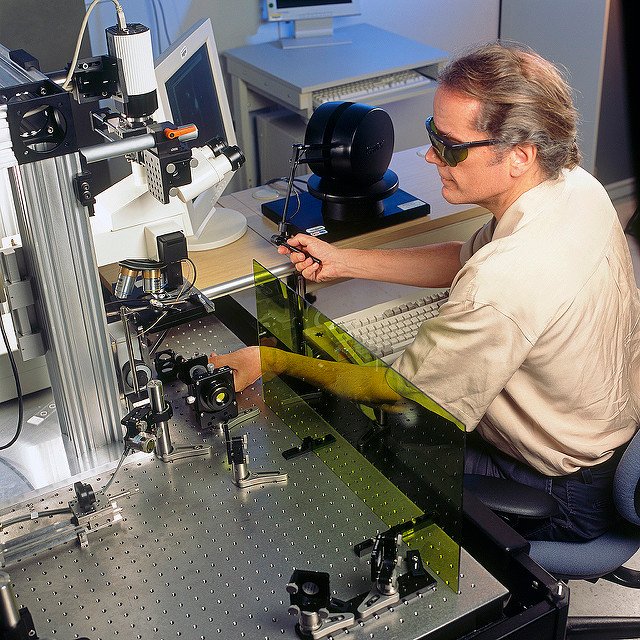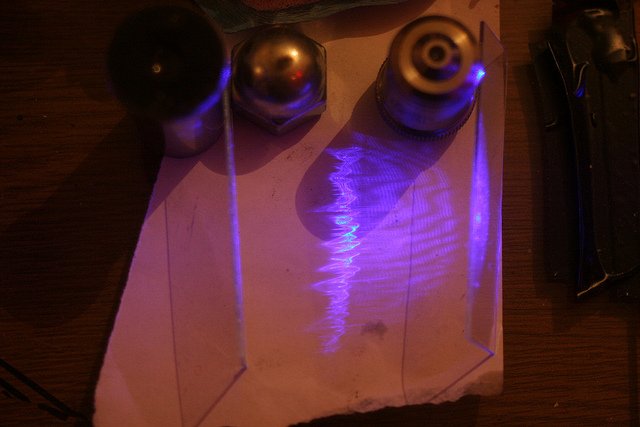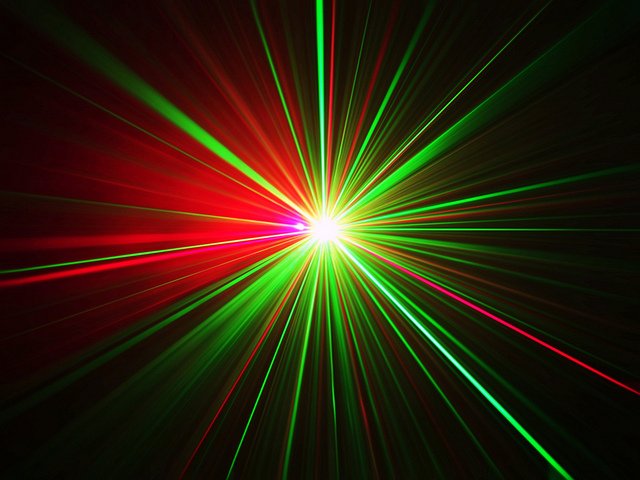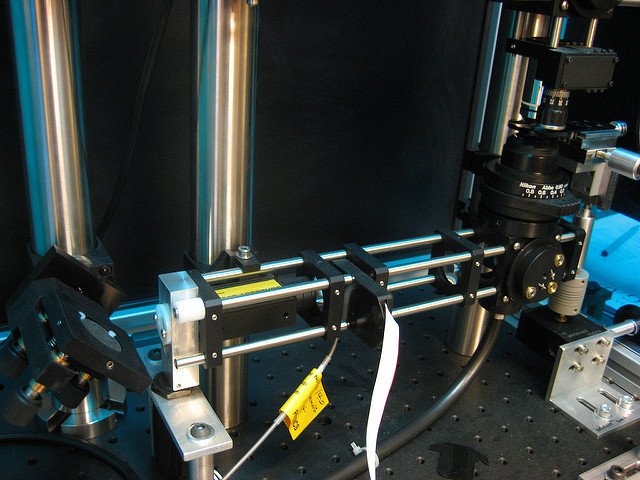Laser Physics and its groundbreaking invention #1: The Optical Tweezers.

Introduction
From the knowledge of high school physics, It is generally known that light is a form of energy that causes a physical feeling of vision thereby making us see. But from further knowledge of physics, it was later got to know that light also has momentum. We do feel the sensation of light in the form of heat when we stand under the sun, but we don't feel the force of push it exerts on us. In spite of that, it is a known fact that whenever a light either shines on, strikes or hits an object, the impact produces an insignificant force on the object. The force from such a collision is known as Radiation Pressure.

Beamie Young/NIST, Public domain
Also, there is the likelihood that light could also apply pressure on objects and that was dated back as far as 1619 when Johannes Kepler posited that it's the pressure of light that affects the appearance of a comet by making its tail never to point towards the sunsource. The idea of radiation pressure was made more reasonable and believable by Isaac Newton in one of his theories on light. He made the path possible for scientists to research more and try to measure the radiation pressure, in which all attempts to do so all proved abortive. But in the year 1873, a scientist named William Crookes came close to measuring the ever elusive radiation pressure but he too got it wrong and his error led to a beautiful invention. He stumbled across what would later be the Radiometer, an instrument found mostly with the opticians, for detecting and measuring the power of an electromagnetic radiation. The radiometer doesn't measure radiation pressure but only responds to the force that acts on the molecular surface heated by sunlight.
Around 1900, three scientists named P. N. Lebedev in Russia, Ernest F. Nichols, and G. F. Hull in the U.S successfully carried out an experiment on the reality of radiation pressure. They were able to detect and measure the magnitude of the force using a moving vane hanged by a fiber in space, thereby confirming the prediction of Maxwell in his theory of electromagnetic waves. The experiments related here, could not have been carried out prior to the discovery of the laser in the year 1960. It was from these experiments that "laser" was birthed.
Lasers
The "Laser" came to being in the early 1960s. The word LASER is an abbreviation formed from the initial letters of the words; Light Amplification by Stimulated Emission of Radiation. It was regarded as one of the greatest contributions of quantum physics to technology. The laser light works in a similar fashion to a lightbulb in such that its light is emitted when atoms move from a higher quantum state to that of a lower state; the only difference is that the emission of a lightbulb is scattered compared to that of a laser light. In laser light, not only are the emissions organized but are also in the same direction and at the same time.

National Cancer Institute, Public domain
So, a laser is formed when the electrons in an atom inside a container such as a glass or even a gas draw in energy from an electrical current and then become “excited.” The excited electrons move from a normal state or lower-energy orbit to an excited stage also known as the higher-energy orbit around the atom’s nucleus. When they go back to their normal or ground state, the electrons emit photons which are also known as particles of light. Therefore, as a result of all these, laser light has some great characteristics that deserved to be looked into to fully understand the concept and how it works. Some of the attributes are:-
The Monochromatism of Laser Light
A monochromatic light is one that is having only one wavelength or frequency. The laser light is very monochromatic in nature. Taking a red-hot bulb as an instance, the light coming from it is stretched out over a steady range of wavelengths and is definitely not of a single wavelength or frequency. Although the emission of energy from a fluorescent light containing neon is monochromatic, to a very small amount like one in a hundred as compared to the sharpness of a laser light which is highly monochromatic. A laser light has only one wavelength (or colour) which is also a result of the quantity of energy liberated when the excited electron falls to a lower energy level.
The Coherence of Laser Light
The word "coherence" according to the Britannica means a definite interconnection between the phase of waves in a beam of radiation of a monochromatic lightsource. It is one of the distinctive attributes of laser light. A laser light is extremely coherent to such an extent that even single long waves (or wave trains) of it can be a few hundred kilometers long. Even when two isolated beams that have moved such an interval of space over separate ways are reunited, they tend to remember their common origin and are able to form an order of interference fringes source. As laser light is very coherent, it remains fixed for an immense space of distances, even to the moon and beyond.

Milan Karakas, Flickr, CC0
The Direction of Laser Light
A laser light has the ability to remain focused for great distances in space not only because it is highly coherent but for also being highly directional. A laser light produces a very compact beam of light, unlike a flashlight that has its light scattered. A laser beam doesn't diverge as much, it deviates from the state of being parallel only because of diffraction at the space through which the laser light passes. Taking the laser pulse for instance, when used to measure the distance from the earth to the moon, it is observed that it creates a spot on the moon's surface with a diameter of only a few kilometers as compared to a lightbulb with divergent parallel beams and diffused radiation.
The Focal point of Laser Light

Benjiman Green, Flickr, Public domain
Laser light is very sharp and focused. If two separate light beams convey the same quantity of energy, the beam that can be concentrated to the smaller point will have the greater intensity (which is the power per unit area) at that point. The intensity of laser light is great and can be as big as 1.01 kilowatt/cm2. Imagine, as bright, sharp and focused as an oxyacetylene flame seems, it's intensity is just 103 watt/cm2 which is very low as compared to that of a laser light.
The Making of a Laser
A laser is a kind of gadget that generates trillions of light particles all at once from billions of atoms and make those light particles form a kind of coherent, monochromatic and focused beam. To make a laser, two fundamental constituents are very essential. The first is to get a load of atoms, either that of a solid, liquid or even gas having some electrons that can be energized. The second is to get a flash tube; somewhat like the xenon flash lamp or at times another laser which we are going to use to energize the atoms. A normal red laser is made up of a long ruby crystal wound with a flash tube in a twisting form.
.JPG)
The flash tube resembles a fluorescent light but for the coil surrounding the ruby crystal which flashes continuously like a camera's flash lamp. According to the diagram below, the flash tube and the crystal produce a laser beam through the following steps:-
- An electric supply of a very high voltage to make the tube flash on and off intermittently.
- Whenever the tube flashes, energy is being injected into the ruby crystal as photons.
- Atoms within the ruby crystal absorb the injected energy in a process otherwise known as absorption. The atoms soak up the energy when they are excited and immediately give off photons (blue blobs) when they return to their ground state. This is also a process known as spontaneous emission.
- The emitted photons move haphazardly within the crystal at a speed of light.
- Every now and then, as the photons continue to travel, one of them electrifies a previously excited atom and that hitherto gives off another photon. So, the photons continue in that same fashion and the light becomes multiplied.
- A mirror placed at the boundary of the laser tube ensures the photons keep rebounding to and fro inside the ruby crystal and a partial mirror is placed at the other end to rebound some photons back and then allow some to break free. Those photons that broke free from the crystal now form a very intense beam of laser light.
Lasers can be found everywhere
Lasers can be found in so small a place as in a microchip or in a place as huge as the NIF. The "NIF" stands for the National Ignition Facility, situated at Lawrence Livermore National Laboratory and is regarded as the world’s largest laser. The NIF has 192 high powered laser beams which are contained in a very big building (10 stories) and can produce few million joules of laser energy in as little a time as a nanosecond pulses on a very small size of a targetsource.
.jpg)
National Ignition Facility (NIF); Public domain
Lasers can be seen in VCD and DVD players, metal cutting machines, voice and data transmission, etc. The modern laser, taking the NIF for instance, can create billions of pulses and generate a power of about five hundred trillion watts. The helium-neon gas lasers, on the other hand, emits a constant uninterrupted light while the ruby lasers are capable of producing pulses which can only last a billionth of a second. Finally, it is unnecessary for a laser light to be visible. Many are invisible, especially the NIF.
Optical tweezer: a tool made of light.
Arthur Ashkin is regarded by many as the father of optical tweezerssource. He is an American scientist and was just recently awarded a Nobel Prize in Physics for his great works on lasers and optical tweezers. His journey started from an imagination on whether beams of light can be made in such a way as to move objects. An example of such was shown in a movie Star Trek, where a hypothetical beam of light was used to bring objects, both small and big without actually touching them. Truly, this appears to be a science fiction. Just as I have highlighted in the introductory paragraph that normally we feel that sunlight carries some energy because we tend to feel hot while under it but the pressure the light exerts on us is so minute that we rarely feel even a tiny push from it. But, could the force from the sunbeams be sufficient enough to push very tiny bits of atoms and particles?
So, as soon as the first laser was invented in 1960, Ashkin immediately began to experiment with it in his lab. He observed that in a laser, the light waves are focused and coherent unlike that of an ordinary white light which are mixtures of scattered colours. So, as a result of that, the scientist concluded that a laser would be the ideal tool for getting light beams to move tiny objects. The next thing he did was to shine a beam of laser light on extremely small particles and he observed that the particles started to move, but more to the middle of the beam where the light was more extreme. In his series of experiments, he used specimen of very small mosaic viruses. he left them open for some hours and observed that the specimen has transformed into large particles moving here and there. Through his microscope, he was able to reveal that those particles were bacteria that was moving closer to the centre of the beam and thereby gotten entrapped in the light.

Simon Lee, Flickr, CC BY-SA 2.0licensed
A justification for that is that regardless of how sharp a laser beam is, its intensity or strength decreases from the centre towards the sides. Hence, the radiation pressure that the laser light applies+ on the particles also differs, since most of the particles are held at the centre of the beam because that's where the pressure is most felt. So, Ashkin added a strong lens to enhance the focus of the laser light to hold the particles firmly in the direction of the beam. So, the particles were then attracted around the point having the greatest intensity of light. That was how a light trap came into being and Ashkin by chance stumbled on what is now known as The Optical tweezers.
The Optical tweezer is a very great invention from Ashkin that has really transformed laser physics and for that, he was honoured with a Nobel prize in Physics. The invention has made it easy to view extremely small particles and fast procedures in a new dimension. It has also ensured that not only physics but biology, chemistry and also medicine have acquired precision and distinctive tools for research and practical uses. The Physics scientist never ceases to be astonished over the invention of his optical tweezers, a sci-fi that is now a reality.
Some of the great uses of the Optical tweezers.
The optical tweezers are not only capable of grabbing atoms and particles but also for holding bacteria, viruses and other live cells for examination and manipulation without altering their forms. These have created absolutely new possibilities for discovering and overseeing the system and structure of life.
.jpg)
NIST, femtomolar Optical tweezers; Public domain
With the optical tweezers, the characteristics of large molecules performing essential functions inside the cells can be analyzed and examined. Typical examples of such molecules to be investigated are protein, kinesin, DNA and the microtubules that constitute the skeleton of a cell.
Another great development is the Optical Holography. It involves a process of using thousands of tweezers concurrently to do some separation such as separating healthy blood cells from the infected ones and can be very applicable in fighting malaria.
Conclusion
The Laser was regarded as one of the greatest contributions of quantum physics to technology. It works in a similar way to a lightbulb but for its monochromatism, coherence, direction and being focused. A laser is capable of producing trillions of light particles all at once from an atom. Lasers can be as big as ten-storey building as in NIF or as small as the components of a microchip. Lasers can also be found in VCD and DVD players and metal cutting machines. From laser, a great invention was made by a scientist Arthur Ashkin. It is a tool made of light called the Optical tweezer in which Ashkin was rewarded for with a Nobel Prize in Physics, 2018. The Optical tweezers have many applications not only in physics but in chemistry, medicine and biology. They can be used to hold atoms, particles, bacteria, viruses and other live cells for examination and manipulation without altering their forms. In conclusion, the optical tweezer is a dream comes true; and according to Ashkin, It is indeed a science fiction that is now a reality.
Thanks for reading.

REFERENCES
How lasers work
Press release:Nobel Prize 2018
What is NIF?
Arthur Ashkin
The Pressure of laser light
The Nobel Prize in Physics
lasers and how they work
The history of Comet Halley
Coherence of laser light
Interference fringe
Holography
Fundamental of Physics, 9th Edition, Halliday-Resnick-Jearl Walker, 2011 pdf

Steem on; Oh ye of great minds!


Nice article.
Btw I am a computational biophysicis PhD student. And I was once very fortunate to get hold of optical tweezers. We pulled chick embryo membrane using an IR tweezer. Here is the video of that:
You can clearly see the membrane getting pulled when polystyrene bead is moving.
Wow... this is awesome. My first time of seeing the process very close. Thanks for sharing.
Congratulations @emperorhassy! You have completed the following achievement on the Steem blockchain and have been rewarded with new badge(s) :
Click here to view your Board of Honor
If you no longer want to receive notifications, reply to this comment with the word
STOPCongratulations! This post has been upvoted from the communal account, @minnowsupport, by emperorhassy from the Minnow Support Project. It's a witness project run by aggroed, ausbitbank, teamsteem, someguy123, neoxian, followbtcnews, and netuoso. The goal is to help Steemit grow by supporting Minnows. Please find us at the Peace, Abundance, and Liberty Network (PALnet) Discord Channel. It's a completely public and open space to all members of the Steemit community who voluntarily choose to be there.
If you would like to delegate to the Minnow Support Project you can do so by clicking on the following links: 50SP, 100SP, 250SP, 500SP, 1000SP, 5000SP.
Be sure to leave at least 50SP undelegated on your account.
This application of optical tweezers in the field of Microbiology is wonderful!
Great job @emperorhassy,
It is nice reading your blog again.
Thanks for coming around.
Truly, It's been a long time.
I'll be looking forward to your post too, sir.
I recently wrote something about lasers. It's good to see this angle of the Nobel prize-winning work. Great post.
Sure, I read it. It's a great piece of write up.
Thanks for coming by.
This post has been voted on by the SteemSTEM curation team and voting trail in collaboration with @utopian-io and @curie.
If you appreciate the work we are doing then consider voting all three projects for witness by selecting stem.witness, utopian-io and curie!
For additional information please join us on the SteemSTEM discord and to get to know the rest of the community!
Congratulations! Your post has been selected as a daily Steemit truffle! It is listed on rank 10 of all contributions awarded today. You can find the TOP DAILY TRUFFLE PICKS HERE.
I upvoted your contribution because to my mind your post is at least 11 SBD worth and should receive 238 votes. It's now up to the lovely Steemit community to make this come true.
I am
TrufflePig, an Artificial Intelligence Bot that helps minnows and content curators using Machine Learning. If you are curious how I select content, you can find an explanation here!Have a nice day and sincerely yours,

TrufflePigDoes this imply that laser are magnetic in nature?
Well, the optical tweezers can fit that description kind of.
Thanks for coming by.
Hi @emperorhassy!
Your post was upvoted by Utopian.io in cooperation with @steemstem - supporting knowledge, innovation and technological advancement on the Steem Blockchain.
Contribute to Open Source with utopian.io
Learn how to contribute on our website and join the new open source economy.
Want to chat? Join the Utopian Community on Discord https://discord.gg/h52nFrV